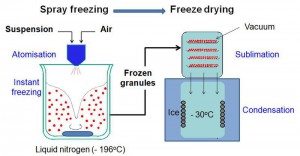
Processing of nanoparticles using Freeze Granulation, Spray Freeze Drying, you will get optimal properties of your nanoparticles when mixing them with other powders or materials. The homogeneity of the powder mixture will be kept throughout the process steps, in spraying, freezing and drying, resulting in a dry granulate with homogeneously distributed nanoparticles.


